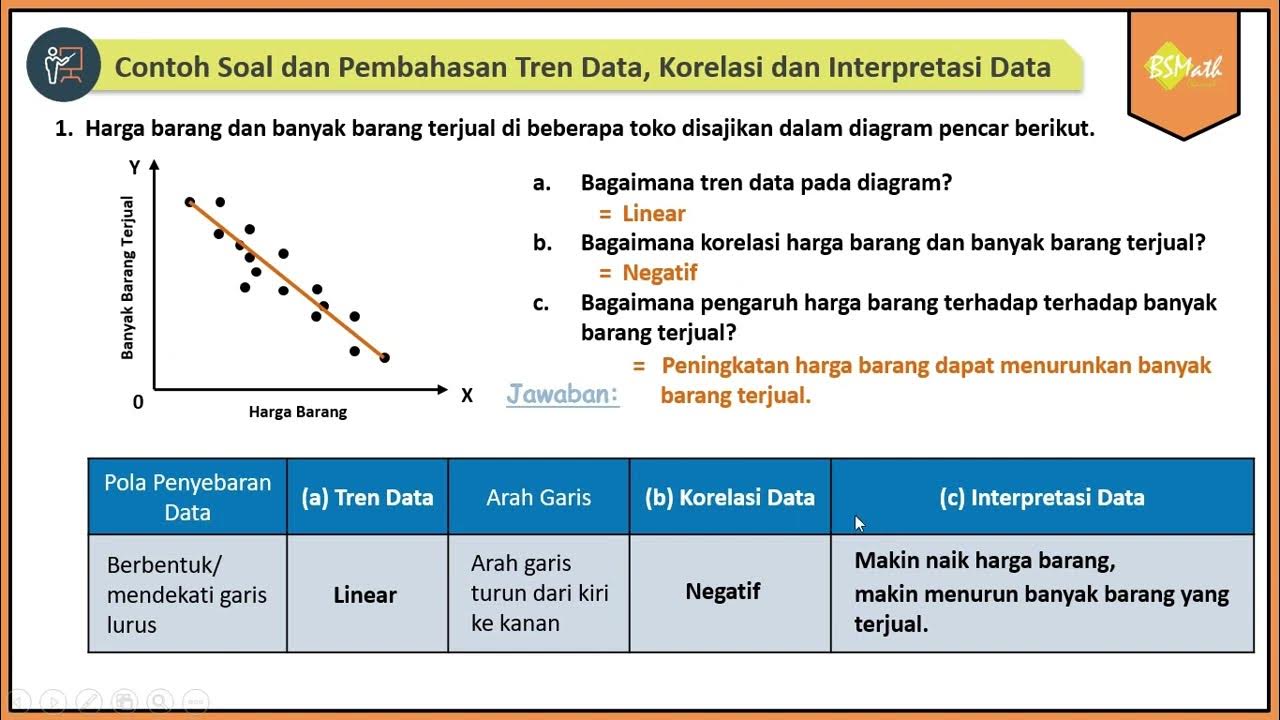Pembahasan Soal Asesmen Akhir Semester Materi Diagram Pencar Nomor 1-5 | Matematika Wajib Kelas XI
Summary
TLDRIn this educational video, the instructor guides Class 11 students through the analysis of bivariate data using scatter plots. The lesson focuses on identifying trends and correlations, helping students understand how to interpret data relationships—whether positive, negative, or non-existent. By plotting data points and analyzing their patterns, students learn how to distinguish between linear and nonlinear trends. The video provides answers to multiple-choice questions based on real examples from the Intan Pariwara textbook, equipping students with practical skills for their upcoming semester assessments.
Takeaways
- 😀 The video is focused on analyzing data using scatter plots and identifying correlations in mathematics for 11th grade students using the Merdeka curriculum.
- 😀 The video covers assessment preparation for the final semester exam, specifically focusing on multiple-choice questions regarding bivariate data.
- 😀 The speaker explains how to plot bivariate data on a Cartesian plane, ensuring each data point is accurately represented.
- 😀 One key skill taught is identifying whether data shows a positive correlation, negative correlation, or no correlation at all.
- 😀 Positive correlation is explained as both variables moving in the same direction: when one increases, the other also increases, or both decrease.
- 😀 The speaker demonstrates how to visually assess whether the trend of data is linear or nonlinear by observing the pattern of points in a scatter plot.
- 😀 Nonlinear data trends are shown as curves or bends, while linear data trends appear as straight lines.
- 😀 In some cases, data does not fit a clear linear or nonlinear trend, making it uncorrelated, as seen in certain scatter plots.
- 😀 The video highlights the importance of recognizing patterns in bivariate data, including how to determine if data correlates positively, negatively, or not at all.
- 😀 The video concludes by reiterating the importance of understanding trends and correlations in data for assessment success, and encourages students to review key concepts for the exam.
Q & A
What is the primary topic discussed in this video?
-The video focuses on teaching how to analyze bivariate data, particularly for class 11 students following the Merdeka curriculum. It discusses how to determine trends and correlations in scatter plots.
What is the first step in analyzing bivariate data in this context?
-The first step is to plot the bivariate data on a Cartesian plane and create a scatter plot for each pair of data points.
How is the correlation between two variables determined from the scatter plot?
-The correlation is determined by observing the pattern or trend of the data points. A positive correlation is indicated by a rising pattern from left to right, while a negative correlation shows a descending pattern.
What does 'correlation positive' mean in the context of the video?
-A positive correlation means that both variables move in the same direction. If one variable increases, the other also increases, or if one decreases, the other decreases.
Which scatter plots were identified as having a positive correlation?
-Scatter plots 1 and 4 are identified as having a positive correlation, as both show a rising trend from left to right.
What is the definition of 'nonlinear trend' as explained in the video?
-A nonlinear trend refers to a pattern in the data where the relationship between the variables cannot be represented by a straight line. Instead, it forms a curved or bending line.
Which scatter plots show a nonlinear trend?
-Scatter plots 3 and 4 show a nonlinear trend, as their data points form a curved or bending line rather than a straight line.
What does 'correlation negative' mean?
-A negative correlation occurs when one variable increases while the other decreases, or vice versa. The trend in the scatter plot will be a descending line from left to right.
Which scatter plots were identified as having a negative correlation?
-Scatter plots 3 and 5 are identified as having a negative correlation, as both show a descending trend from left to right.
What is meant by 'no correlation' or 'zero correlation' in the context of the scatter plot?
-No correlation means there is no discernible relationship between the two variables. The data points are scattered without forming any clear pattern, whether ascending or descending.
Outlines

This section is available to paid users only. Please upgrade to access this part.
Upgrade NowMindmap

This section is available to paid users only. Please upgrade to access this part.
Upgrade NowKeywords

This section is available to paid users only. Please upgrade to access this part.
Upgrade NowHighlights

This section is available to paid users only. Please upgrade to access this part.
Upgrade NowTranscripts

This section is available to paid users only. Please upgrade to access this part.
Upgrade NowBrowse More Related Video

Menggambar Diagram Pencar Kelas XI Fase F Kurikulum Merdeka

Video Materi Pengenalan Visualisasi Data

Menggambar Diagram Pencar Secara Manual - Matematika Wajib SMA Kelas XI Kurikulum Merdeka

Statistika - Penyajian Data Eps.2 l Ruang Belajar #StudyWithDiida

Belajar Statistika - Makna & Intepretasi Diagram Pencar (Scatter Plot)

Contoh Soal dan Pembahasan Tren Data, Korelasi dan Interpretasi Data Bivariat Diagram Pencar
5.0 / 5 (0 votes)